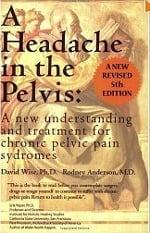If you have chronic pelvic pain that temporarily goes away after orgasm, you may find this information useful.  It’s from A Headache in the Pelvis, a New Understanding and Treatment for Chronic Pelvic Pain Syndromes, 6th edition, by David Wise PhD and Rodney Anderson MD. For more information go to https://www.pelvicpainhelp.com/
It’s from A Headache in the Pelvis, a New Understanding and Treatment for Chronic Pelvic Pain Syndromes, 6th edition, by David Wise PhD and Rodney Anderson MD. For more information go to https://www.pelvicpainhelp.com/
Excerpts:
Pelvic pain is sometimes the price paid for using compulsive orgasm to fight depression or anxiety
One of the things that happens when orgasm and compulsive sexual activity is used to fight depression and anxiety, is that the pelvic floor is forced continually to strongly contract and relax during the pleasure spasm of orgasm. When someone has some form of chronic pelvic pain syndrome, this continual pleasure spasm of ejaculation ratchets up the tone of the pelvic muscles and can cause them to remain chronically and painfully tightened up for hours or days.
Forcing an already tight and painful pelvic floor to frequently contract through compulsive masturbation will tend to make pelvic pain worse
Compulsive masturbation can push the prostate, seminal vesicles and pelvic floor muscles to overwork. When the frequency and level of intense contraction of these muscles is sustained beyond a certain point, the chronic pelvic pain may be triggered. If the syndrome is already present, compulsive sexual activity will often exacerbate it.
It is very common for men with prostatitis/chronic pelvic pain syndrome and for women with pelvic pain/pelvic floor dysfunction to experience increased discomfort or pain hours or the next day after orgasm. The reason that there is often an increase in discomfort during or after sexual activity in men and women with chronic pelvic pain syndromes is as follows. Orgasm causes strong contractions of the pelvic, prostate and seminal vesicle muscles lasting about once every second during orgasm. There are some individuals we have seen who have been addicted to pornography who temporarily reduce their pelvic pain by frequent masturbation because masturbation typically reduces pelvic pain briefly only to flare it up later.
Orgasm as a pleasure spasm
Pelvic pain researcher Dr. Jeannette Potts observed that orgasm is a pleasure spasm. There is a significant increase in nervous system arousal during sexual activity. The pleasure spasm of orgasm in the form of the increased series of contractions during orgasm will tighten the pelvic muscles further. This increased tightening temporarily contracts already contracted pelvic floor muscles and tends to throw the pelvic pain sufferer further above the symptom threshold. After a certain period of time has passed, the pelvic muscles relax and return to their baseline levels, the normal state of the pelvic floor reasserts itself (which is back to some degree of pain or discomfort when a person has chronic pelvic pain syndrome).
Compulsive sexual activity can trigger or exacerbate pelvic pain
There are some individuals who deal with their anxiety and depression by engaging in compulsive sexual activity and masturbation. Anxiety and depression momentarily disappear during orgasm. This disappearance of anxiety or depression after orgasm is almost always short-lived as clearly explained in Cupid’s Poisoned Arrow. The fact that there has been a great rise in the availability of pornography on the internet may be a factor that has rarely been taken into account in the understanding and treatment of pelvic pain of certain individuals as compulsive masturbation can trigger what is commonly called prostatitis, chronic pelvic pain syndrome or pelvic floor dysfunction.
Pelvic pain can be triggered and exacerbated by engaging in compulsive sexual activity
It is a common experience that repeated orgasms in close proximity yield diminishing levels of pleasure. The diminishment of pleasure with frequent orgasm also yields diminishing relief from anxiety and depression. It is not well known that compulsive sexual activity and pornography will tend to make anxiety and depression worse and not alleviate it as well as sometimes triggering chronic pelvic pain syndromes.